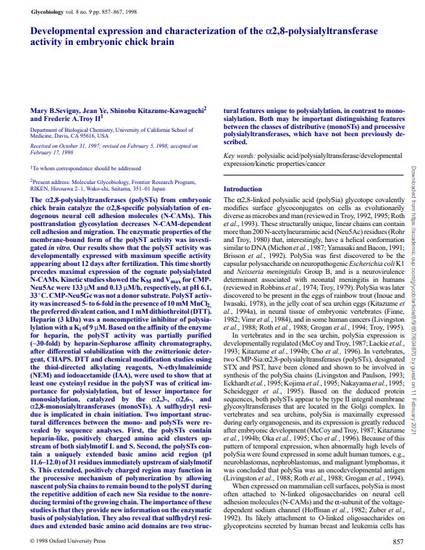
The alpha2,8-polysialyltransferases (polySTs) from embryonic chick brain catalyze the alpha2,8-specific polysialylation of endogenous neural cell adhesion molecules (N-CAMs). This posttranslation glycosylation decreases N-CAM-dependent cell adhesion and migration. The enzymatic properties of the membrane-bound form of the polyST activity was investigated in vitro. Our results show that the polyST activity was developmentally expressed with maximum specific activity appearing about 12 days after fertilization. This time shortly precedes maximal expression of the cognate polysialylated N-CAMs. Kinetic studies showed the KMand Vmaxfor CMP-Neu5Ac were 133 microM and 0.13 microM/h, respectively, at pH 6.1, 33 degrees C. CMP-Neu5Gc was not a donor substrate. PolyST activity was increased 5- to 6-fold in the presence of 10 mM MnCl2,the preferred divalent cation, and 1 mM dithiothreitol (DTT). Heparin (3 kDa) was a noncompetitive inhibitor of polysialylation with a Kiof 9 microM. Based on the affinity of the enzyme for heparin, the polyST activity was partially purified ( approximately 30-fold) by heparin-Sepharose affinity chromatography, after differential solubilization with the zwitterionic detergent, CHAPS. DTT and chemical modification studies using the thiol-directed alkylating reagents, N-ethylmaleimide (NEM) and iodoacetamide (IAA), were used to show that at least one cysteinyl residue in the polyST was of critical importance for polysialylation, but of lesser importance for monosialylation, catalyzed by the alpha2,3-, alpha2,6-, and alpha2,8-monosialyltransferases (monoSTs). A sulfhydryl residue is implicated in chain initiation. Two important structural differences between the mono- and polySTs were revealed by sequence analyses. First, the polySTs contain heparin-like, positively charged amino acid clusters upstream of both sialylmotif L and S. Second, the polySTs contain a uniquely extended basic amino acid region (pI 11. 6-12.0) of 31 residues immediately upstream of sialylmotif S. This extended, positively charged region may function in the processive mechanism of polymerization by allowing nascent polySia chains to remain bound to the polyST during the repetitive addition of each new Sia residue to the nonreducing termini of the growing chain. The importance of these studies is that they provide new information on the enzymatic basis of polysialylation. They also reveal that sulfhydryl residues and extended basic amino acid domains are two structural features unique to polysialylation, in contrast to monosialylation. Both may be important distinguishing features between the classes of distributive (monoSTs) and processive polysialyltransferases, which have not been previously described.
Available at: http://works.bepress.com/mary-sevigny/10/
